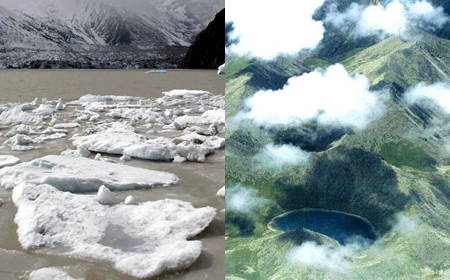| Tibet has felt some of the largest impact of global warming, China Meteorological Administration (CMA) chief Zheng Guoguang said here Wednesday.
"In Tibet, the mercury has climbed an average 0.32 degrees Celsius every decade since records began in 1961," Zheng told more than 500 officials at a meeting in Lhasa on climate change. "This is much higher than the national average temperature rise of 0.05-0.08 degrees Celsius every 10 years."
 |
|
Temperatures in Tibet have risen continuously over the past 48 years at a rate much higher than the national level, a meteorologist said Monday. (Xinhua Photo) |
Tibet's temperature rise had also topped the global average of 0.2 degrees Celsius per decade.
The plateau region, with an average altitude above 4,000 meters, is a "magnifier" of global warming as it is more sensitive to temperature changes, Zheng said.
He said greenhouse gas tends to affect higher altitudes, but Tibet, given its underdeveloped industries, produces little greenhouse gas itself.
"The impact of global warming has accelerated glacial shrinkage and the melting glaciers have swollen Tibet's lakes," he said. "If the warming continues, millions of people in western China would face floods in the short term and drought in the long run."
Further, extreme weather conditions often cause geological disasters including mud-rock flows and landslides, he said.
In the worst case, Zheng warned such warming could cause permafrost to melt and threaten the plateau railway linking Tibet with the neighboring Qinghai Province.
A report by Tibet's regional meteorological bureau earlier this year also warned the permafrost that lies on the path of the rail link had been shrinking by 4.5 centimeters to 24.9 cm every decade since the 1960s.
The report quoted figures from four observatories along the route, saying the fastest shrinkage was reported in Amdo County, which has 346 kilometers of the railway.
While experts believe that at the current thawing speed, the railway will remain safe for another four decades, the government has spent more than 1 billion yuan (143 million U.S. dollars) in the past 20 years to reinforce the Qinghai-Tibet Highway, also plagued by retreating permafrost.
"Tibet needs to tackle, and adapt to, the persisting climate change," said Zheng, who advised the autonomous region to speed up construction of hydropower stations and exploitation of renewable energy.
The regional government said Tibet has built a meteorological observation network consisting 48 ground observatories and four radar stations to monitor climate changes 24 hours a day.
(Xinhua News Agency May 6, 2009) | 